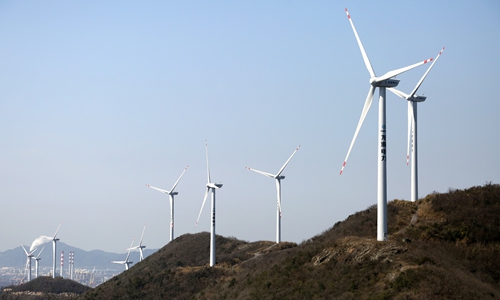Document would reduce costs of electricity and rent in China
Source: Global Times Published: 2020/7/29 14:18:41

On Monday, 17 turbines generate electricity at the Jintangfeng wind farm (????) in Zhoushan, East China's Zhejiang Province. In 2019, total of 44.59 million kilowatt hours of electricity were fed into the grid, eliminating about 44,500 tons of carbon emissions in theory. Photo: cnsphoto
Four government departments on Tuesday issued a document suggesting policies to reduce business costs. Sectors including new energy vehicles (NEVs), logistics and small and medium enterprises would benefit most from the implementation of these policies.
According to the document, the policies would focus on strengthening financial support for the real economy, reducing labor and rent costs, and land and logistics costs. The document proposed commercial bandwidth costs should be reduced by 15 percent, and commercial electricity costs by 5 percent by the end of the year.
Electricity consumption in China has been on the rise and is a significant business cost. Last year, electricity consumed at local power exchange centers totaled more than 4.65 trillion kilowatt hours, up 4.4 percent from 2018. Under a 2019 cost reduction policy, total electricity costs were reduced by 84.6 billion yuan ($12.08 billion).
The document also made suggestions to reduce labor and rent costs. According to statistics from the Ministry of Human Resources and Social Security, enterprises' costs are expected to be reduced by a total of 1.6 trillion yuan for the whole year.
The most direct beneficiaries of the potential cost reductions would be the NEV and logistics sectors. The logistics sector is expected to enjoy over 130 billion yuan in cost reductions for 2020.
Global Times
Posted in: ECONOMY